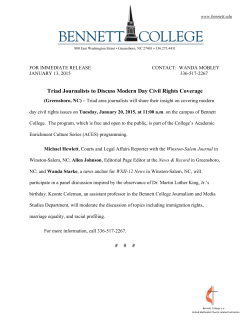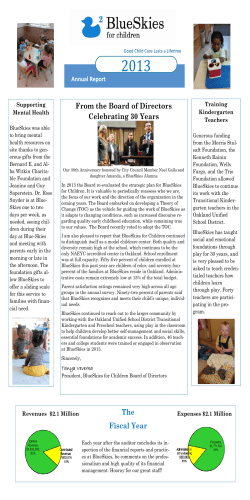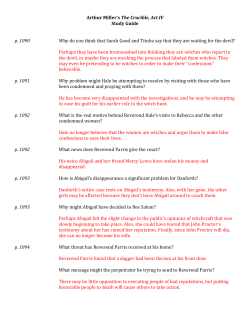
Vita - TCU Biology Department
Amanda M. Hale - page 1 of 6 AMANDA M. HALE Curriculum Vita Department of Biology Texas Christian University TCU Box 298930 Fort Worth, TX 76129 [email protected] phone: (817) 257-6182 fax: (817) 257-6177 www.bio.tcu.edu/faculty/hale.htm EDUCATIONAL BACKGROUND Ph.D. in Biology, University of Miami M.S. in Ecology, Purdue University B.S. in Biology and B.A. in Spanish, Phi Beta Kappa, Purdue University La Complutense, The University of Madrid, Spain 2004 1998 1995 1993-1994 YEAR OF APPOINTMENT TO THE UNIVERSITY AND RANK 2013 2008 2007 Associate Professor of Biology, Texas Christian University Assistant Professor of Biology, Texas Christian University Visiting Research Professor, Texas Christian University PREVIOUS TEACHING AND RESEARCH APPOINTMENTS 2005-2007 2005 Postdoctoral Associate, Department of Biology, University of Miami Lecturer, Department of Biology, University of Miami CURRENT GRANTS Texturizing wind turbine towers to reduce bat mortality. Co-PI with V. Bennett. Wind Energy – Bat Impact Minimization Technologies and Field Testing Opportunities” – FOA # DE-FOA0001181, (Award Negotiation) Ultrasonic bat deterrent technology. PI – K. Kinzie, General Electric. Wind Energy – Bat Impact Minimization Technologies and Field Testing Opportunities” – FOA # DE-FOA0001181, Sub-award to A. Hale & V. Bennett (Award Negotiation) Development and testing of a practical deterrent to minimize bat fatalities at wind turbines. Co-PI with V. Bennett. NextEra Energy Resources TCU – NextEra Energy Wind Research Initiative: Phase 2 (2013-2015), Co-PI with M. Slattery, V. Bennett, and B. Johnson GRADUATE THESES DIRECTED Jonathan Scott, MS Environmental Science, expected Dec. 2016 – How bats respond to various ultrasonic stimuli: a study to inform an acoustic deterrent for wind turbines. Co-advised with Victoria Bennett. Cecily F. Foo, MS Biology, expected May 2016 – Are wind turbines a foraging resource for bats? Testing the feeding attraction hypothesis. Co-advised with Victoria Bennett. Amanda M. Hale - page 2 of 6 Christina R. Bienz, MS Environmental Science, expected May 2016. – Surface texture discrimination by wild-caught bats: implications for reducing bat mortality at wind turbines. Co-advised with Victoria Bennett. Luyi Z. Jarzombek, MS Environmental Science, expected May 2016. – Test of the acoustic mirror effect in insectivorous bats foraging at wind turbine towers. Co-advised with Victoria Bennett. Brad R. Yuen, MS Environmental Science, expected Dec. 2015 – Surface texture discrimination using synthetic bat echolocation calls: implications for reducing bat fatalities at wind turbines. Coadvised with Victoria Bennett. Aaron M. McAlexander, MS Biology, 2013 – Evidence that bats perceive wind turbine surfaces to be water. C. Danielle Cochran, MS Environmental Science, 2013 – Bats, bugs and wind farms – is there a connection? Jennifer M. Korstian, MS Biology, 2012 – High genetic diversity and lack of structure in eastern red bats (Lasiurus borealis). Co-advised with Dean Williams. Erin S. Hatchett, MS Environmental Science, 2011 – Wind turbines do not negatively impact density and nest success in grassland birds at a north Texas wind farm. Thomas K. Stevens, MS Environmental Science, 2011 – The effects of wind energy on overwintering grassland birds. Jeffrey A. Meyer, MS Environmental Science, 2010 – Effects of wind turbines on breeding grassland birds in north-central Texas. Trevor G. Rubenstahl, MS Environmental Science, 2010 – Scissor-tailed Flycatcher (Tyrannus forficatus) nest placement and success in relation to wind turbines at a utility-scale wind farm in northcentral Texas. PUBLICATIONS Korstian JM, AM Hale, and DA Williams. In press. High genetic diversity, large historic population size, and lack of population structure in two North American tree bats. Journal of Mammalogy. Groff PA, AM Hale, and BA Whitlock. 2015. Chloroplast lineages in disjunct western North American populations of Swertia perennis (Gentianaceae). Systematic Botany 40:220-228. Bennett VJ, and AM Hale. 2014. Red aviation lights on wind turbines do not increase bat-turbine collisions. Animal Conservation 17:354-358. Bennett VJ, AM Hale, KB Karsten, CE Gordon, and BJ Suson. 2014. Effect of wind turbine proximity on nesting success in shrub-nesting birds. American Midland Naturalist 172:317-328. Hale AM, ES Hatchett, JA Meyer, and VJ Bennett. 2014. No evidence of displacement due to wind turbines in breeding grassland songbirds. The Condor: Ornithological Applications 116:472-482. Horner JD, EB Hodcroft, AM Hale, and DA Williams. 2014. Clonality, genetic variation, and the origin of isolated western populations of the carnivorous plant, Sarracenia alata. Journal of the Torrey Botanical Society 141:326-337. Korstian JM, AM Hale, and DA Williams. 2014. Development and characterization of microsatellite loci for eastern red and hoary bats (Lasiurus borealis and L. cinereus). Conservation Genetics Resources 6:605-607. doi: 10.1007/s12686-014-0151-6. Hatchett ES, AM Hale, VJ Bennett, and KB Karsten. 2013. Wind turbines do not negatively affect nest success in the Dickcissel (Spiza americana). The Auk 130:520-528. Amanda M. Hale - page 3 of 6 Korstian JM, AM Hale, VJ Bennett, and DA Williams. 2013. Advances in sex determination in bats and its utility in wind-wildlife studies. Molecular Ecology Resources 13:776-780. Stevens TK, AM Hale, KB Karsten, and VJ Bennett. 2013. An analysis of displacement from wind turbines in a wintering grassland bird community. Biodiversity and Conservation 22:1755-1767. Rubenstahl TG, AM Hale, and KB Karsten. 2012. Nesting success of Scissor-tailed Flycatchers (Tyrannus forficatus) at a wind farm in northern Texas. Southwestern Naturalist 57:189-194. Williams DA, C Leach, AM Hale, KB Karsten, E Mujica, D Barber, LA Linam, and N Rains. 2012. Development of tetranucleotide microsatellite loci and a non-invasive DNA sampling method for Texas horned lizards (Phrynosoma cornutum). Conservation Genetics Resources 4:43-45. doi: 10.1007/s12686-011-9469-5. Whitlock BA, AM Hale, JL Indorf, and CF Wilkins. 2011. Polyphyly of Rulingia and Commersonia (Lasiopetaleae, Malvaceae s.l.). Australian Systematic Botany 24:215-225. Whitlock BA, and AM Hale. 2011. The phylogeny of Ayenia, Byttneria, and Rayleya (Malvaceae s.l.) and its implications for the evolution of growth forms. Systematic Botany 36:129-136. Whitlock BA, AM Hale, and PA Groff. 2010. Intraspecific inversions pose a challenge for the trnH-psbA plant DNA barcode. PLoS ONE 5(7): e11533. doi:10.1371/journal.pone.0011533. Williams DA, and AM Hale. 2008. Investment in nesting activities and patterns of within- and extragroup genetic paternity in a cooperatively breeding bird. The Condor 110:13-23. Williams DA, and AM Hale. 2007. Female-biased helping in a cooperatively breeding bird: female benefits or male costs? Ethology 113:534-542. Hale AM. 2006. The structure, context, and functions of group singing in black-breasted wood-quail (Odontophorus leucolaemus). Behaviour 143:511-533. Hale AM. 2006. Group living in the black-breasted wood-quail and the use of playbacks as a survey technique. The Condor 108:107-119. Williams DA, and AM Hale. 2006. Helper effects on offspring production in cooperatively breeding brown jays (Cyanocorax morio). The Auk 123:847-857. Hale AM. 2004. Predation risk associated with group singing in a Neotropical wood-quail. The Wilson Bulletin 116:167-171. Williams DA, E Berg, AM Hale, and CR Hughes. 2004. Characterization of microsatellites for parentage studies of white-throated magpie-jays (Calocitta formosa) and brown jays (Cyanocorax morio). Molecular Ecology Notes 4:509-511. Hale AM, DA Williams, and KN Rabenold. 2003. Territoriality and neighbor assessment in brown jays (Cyanocorax morio) in Costa Rica. The Auk 120:446-456. Hale AM, and CR Hughes. 2003. Characterization of polymorphic microsatellite loci in a Neotropical wood-quail, Odontophorus leucolaemus. Molecular Ecology Notes 3:508-510. PRESENTATIONS (Past 3 years) Bennett VJ, and AM Hale. 2015. Exploring potential hypotheses behind bat-wind turbine collisions. American Wind Energy Association (AWEA) Wind Project Siting Seminar. Austin, TX. Bennett VJ, AM Hale, AJ Schildt, BG Cooper, AM McAlexander, and DA Williams. 2014. Exploring potential hypotheses behind bat-wind turbine collisions. National Wind Coordinating Collaborative Wind Wildlife Research Meeting X. Broomfield, CO. Hale AM, and VJ Bennett. 2014. Investigating the benefits of fine-tuning curtailment strategies at operational wind facilities. National Wind Coordinating Collaborative Wind Wildlife Research Meeting X. Broomfield, CO. Amanda M. Hale - page 4 of 6 Bennett VJ, AM Hale, AJ Schildt, and DA Williams. 2014. Evidence that bats utilize wind turbines as a foraging resource. National Wind Coordinating Collaborative Wind Wildlife Research Meeting X. Broomfield, CO. Bennett V, A Hale, A Schildt, B Cooper, A McAlexander, and D Williams. 2014. Exploring potential hypotheses behind bat-wind turbine collisions. 44th Annual Meeting of the North American Society for Bat Research. Albany, NY. Hale A, and V Bennett. 2014. Investigating the benefits of fine-tuning curtailment strategies at operational wind facilities. 44th Annual Meeting of the North American Society for Bat Research. Albany, NY. Korstian J, A Schildt, V Bennett, D Williams, and A Hale. 2014. A method for PCR-based identification of species from bat fecal samples. 44th Annual Meeting of the North American Society for Bat Research. Albany, NY. Hale AM*, ES Hatchett, TK Stevens, JA Meyer, TG Rubenstahl, KB Karsten, and VJ Bennett. 2014. Limited evidence of indirect effects of wind turbines on grassland songbirds. Joint Meeting of the American Ornithologists’ Union, the Cooper Ornithological Society, and the Society of Canadian Ornithologists. Estes Park, CO. *Invited Symposium Bennett VJ, AM Hale, AJ Schildt, and DA Williams. 2014. Evidence that bats utilize wind turbines as a foraging resource. American Society of Mammalogists Annual Meeting. Oklahoma City, OK. Slattery M, AM Hale, and VJ Bennett. 2014. Environmental, social, and economic impacts of utility-scale wind energy projects. 7th World Future Energy Summit. Abu Dhabi, United Arab Emirates. Hale AM*, T Alison, and C Hein. 2013. An overview of wind-wildlife research and information sources with implications for resource management. The Wildlife Society Annual Conference. Milwaukee, WI. *Invited Symposium Hale AM, AM McAlexander, VJ Bennett, and BG Cooper. 2013. A test of a novel attraction hypothesis – why are bats attracted to wind turbines? The Wildlife Society Annual Conference. Milwaukee, WI. Bennett VJ, and AM Hale. 2013. Site-specific wind turbine curtailment has its advantages. The Wildlife Society Annual Conference. Milwaukee, WI. Hale AM, and VJ Bennett. 2013. What can we learn from long-term post-construction fatality monitoring at a wind facility? The Wildlife Society Annual Conference. Milwaukee, WI. Hale AM, AM McAlexander, VJ Bennett, and BG Cooper. 2013. A test of a novel attraction hypothesis: why are bats attracted to wind turbines? 16th International Bat Research Conference & 43rd Annual Meeting of the North American Society for Bat Research. San Jose, Costa Rica. Bennett VJ, and AM Hale. 2013. Site-specific wind turbine curtailment has its advantages. 16th International Bat Research Conference & 43rd Annual Meeting of the North American Society for Bat Research. San Jose, Costa Rica. Hale AM, JM Korstian, VJ Bennett, and DA Williams. 2012. Can genetics and stable isotopes be used to gain geographical insights into the seasonal movement patterns and population structure of eastern red bats (Lasiurus borealis)? National Wind Coordinating Collaborative Wind Wildlife Research Meeting IX. Broomfield, CO. Bennett VJ, and AM Hale. 2012. Can resource and activity hotspot mapping predict bat fatalities at wind turbines? National Wind Coordinating Collaborative Wind Wildlife Research Meeting IX. Broomfield, CO. Amanda M. Hale - page 5 of 6 Bennett VJ, C Sutter, AM Hale, A Costello, and K Heist. 2012. Can bat fatality be predicted from bat acoustic activity within the rotor-swept zone? National Wind Coordinating Collaborative Wind Wildlife Research Meeting IX. Broomfield, CO. Bennett VJ, C Sutter, AM Hale, A Costello, and K Heist. 2012. Can species-specific acoustic activity be relied upon to predict bat fatality at wind turbines? 42nd North American Symposium on Bat Research. San Juan, Puerto Rico. Korstian J, A Hale, V Bennett, and D Williams. 2012. A genetic method to determine the sex of Lasiurus bat carcasses found at wind farms. 42nd Annual Meeting of the North American Society for Bat Research. San Juan, Puerto Rico. Bennett VJ, and AM Hale. 2012. The use of resource and activity hotspot mapping to predict bat-wind turbine interactions. The Wildlife Society Annual Meeting. Portland, OR. Bennett VJ, and AM Hale. 2012. The use of resource and activity hotspot mapping to predict bat-wind turbine interactions. American Society of Mammalogists Annual Meeting. Reno, NV. Korstian JM, AM Hale, and DA Williams. 2012. High diversity and lack of genetic structure in eastern red bats (Lasiurus borealis). American Society of Mammalogists Annual Meeting. Reno, NV. Hale AM, KB Karsten, JA Meyer, ES Hatchett, TG Rubenstahl, TK Stevens, and VJ Bennett. 2012. Limited indirect effects of wind turbines on resident birds. AWEA WindPower 2012 Conference & Exhibition. Atlanta, GA. Bennett VJ, and Hale AM. 2012. Exploring ways to make wind turbines more bat friendly, both physically and operationally. AWEA WindPower 2012 Conference & Exhibition. Atlanta, GA. Hale AM, KB Karsten, and VJ Bennett. 2012. Recommendations for fatality monitoring studies at utilityscale wind farms. Association of American Geographers Annual Meeting. New York, NY. Bennett VJ, AM Hale, and KB Karsten. 2012. Toward an understanding of the effects of wind turbines on bats. Association of American Geographers Annual Meeting. New York, NY. Hatchett E, AM Hale, and KB Karsten. 2012. No effect of wind turbines on density and nest success of Dickcissels (Spiza americana) in north Texas. Association of American Geographers Annual Meeting. New York, NY. Korstian J, DA Williams, AM Hale, and VJ Bennett. 2012. Population genetics of migrating eastern red bats (Lasiurus borealis). Association of American Geographers Annual Meeting. New York, NY. Stevens TK, AM Hale, KB Karsten, and VJ Bennett. 2012. The effects of wind energy on over-wintering grassland birds. Association of American Geographers Annual Meeting. New York, NY. Karsten KB, and AM Hale. 2012. Using meteorological data to predict bat mortality at a wind facility in Texas. Society for Integrative and Comparative Biology Annual Meeting. Charleston, NC. INVITED SEMINARS Hale AM, and VJ Bennett. 2015. Reducing bat mortality at wind turbines: curtailment and testing hypotheses of attraction. The Dallas Zoo, Dallas, TX. Hale AM, and VJ Bennett. 2015. Impacts of wind energy on birds and bats: research priorities and new initiatives. NextEra Energy Resources, Juno Beach, FL. Hale AM. 2015. Impacts of wind energy on birds and bats. Audubon Dallas, Dallas, TX. Hale AM. 2015. Indirect effects of wind energy on grassland songbirds. The Dallas Zoo, Dallas, TX. Hale AM. 2014. Bat mortality at wind turbines – why is it happening and can we lessen the impacts? Department of Biological Sciences, Sam Houston State University, Huntsville, TX. Amanda M. Hale - page 6 of 6 Hale AM, and VJ Bennett. 2014. Impacts of wind energy on bats: research priorities and innovations to reduce bat mortality. General Electric, Greenville, SC. Hale AM. 2014. Impacts of wind energy on birds and bats. Ministry of Natural Resources, Peterborough, Ontario, Canada. Hale AM. 2014. Wind energy and bats – can we lessen the impacts? Department of Biology, Baylor University, Waco, TX. Hale AM, VJ Bennett, BL Johnson, and K Wyrick. 2014. TCU’s women of wind: a panel discussion on wind energy, wind-wildlife issues, and social politics associated with wind energy. American Association of University Women (AAUW) Tarrant County (TX) Branch January Meeting. Sponsored by the TCU Women’s Studies Program. Hale AM, and VJ Bennett. 2014. Impacts of wind energy on birds and bats: research priorities and new initiatives. NextEra Energy Resources, Juno Beach, FL. Hale AM, and VJ Bennett. 2013. Impacts of wind energy on birds and bats: research priorities and new initiatives. NextEra Energy Resources & Wolf Ridge Wind, LLC, Muenster, TX. Hale AM, and VJ Bennett. 2012. Impacts of wind energy on birds and bats: research priorities and new initiatives. NextEra Energy Resources & Wolf Ridge Wind, LLC, Muenster, TX. Hale AM. 2012. Impacts of wind energy on birds and bats. Department of Biology, The University of Texas at Tyler, Tyler, TX. Hale AM. 2011. Impacts of wind energy on birds and bats. Fort Worth Audubon Society. Fort Worth, TX. Hale AM, and KB Karsten. 2009. Impacts of wind energy on birds and bats: data from a wind farm in north-central Texas. The Dallas Zoo. Dallas, TX. Williams DA, and AM Hale. 2009. Conservation genetics of the Texas horned lizard. The Dallas Zoo. Dallas, TX. Hale AM. 2009. Bird and bat monitoring efforts at Wolf Ridge Wind. TCU-Oxford-NextEra Energy Research Partnership Advisory Board Meeting. Fort Worth, TX. Hale AM. 2007. Group structure and restricted dispersal in a neotropical wood-quail. Department of Biology, Texas Christian University, Fort Worth, TX. Hale AM. 2007. Group structure and restricted dispersal in a neotropical wood-quail. Department of Natural Sciences, University of Michigan – Dearborn, Dearborn, MI. Hale AM. 2005. Group structure and sex-biased dispersal in a neotropical wood-quail. Department of Zoology, University of Florida, Gainesville, FL. Hale AM. 2005. Group structure and sex-biased dispersal in a neotropical wood-quail. Department of Biology, University of New Mexico, Albuquerque, NM. MEMBERSHIPS AND SERVICE TO PROFESSIONAL ORGANIZATIONS American Ornithologist’s Union, American Wind Wildlife Institute (AWWI) – Science Advisor, Animal Behavior Society, Associate Editor to The Condor: Ornithological Applications, Association of Field Ornithologists, Botanical Society of America, Cooper Ornithological Society, Horned Lizard Conservation Society, The Wildlife Society, Wilson Ornithological Society Updated: 22 May 2015
© Copyright 2025









